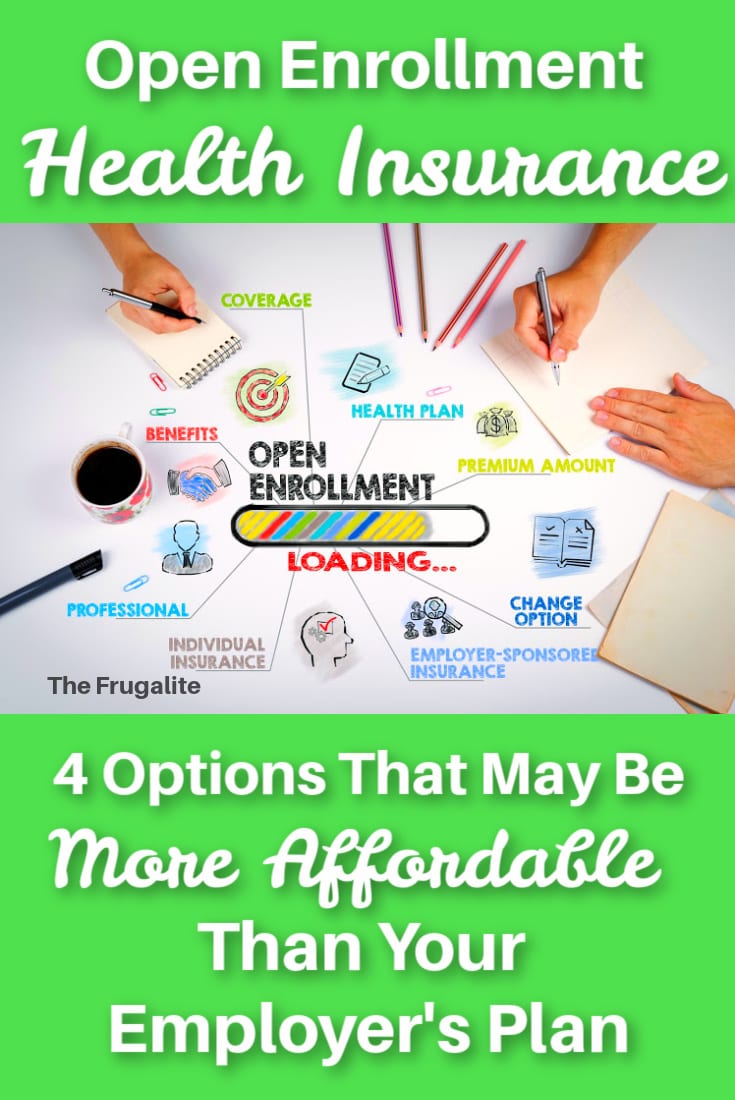(Psst: The FTC wants me to remind you that this website contains affiliate links. That means if you make a purchase from a link you click on, I might receive a small commission. This does not increase the price you’ll pay for that item nor does it decrease the awesomeness of the item. ~ Daisy)
by Mama on Fire
As a full-time working mom, Open Enrollment is always an annually dreaded, expensive event in the life of adulting. Once again, and especially with the financial crunch brought on by the current pandemic economy, my employer is tightening its collective belt. Our employer-provided medical, dental, and vision plans remind me again how outrageous the premiums, deductibles, and out-of-pocket maximums are, and just what little benefit we receive back in return.
I’ve done the math, and even with my employer covering me, the employee, we’re still paying $17,000 out-of-pocket for medical insurance premiums and meeting our family deductible before this so-called “insurance” kicks in. There’s some over-simplification there, yes, but that’s what it pretty much boils down to for our family and our situation.
The last time I bought into this was four years ago, and I can tell you, this mostly healthy family never even came close to meeting that family deductible. Of course, knock on wood, there are catastrophic situations, major events, and chronic conditions that would cause us to be grateful for having such financial protection. For us, we have much better ways we’d rather keep $17,000 in our own bank account, and invest this money in our own self-insured health fund. At the end of the year, this money no longer disappears into the coffers of the medical establishment, disguised as “covering” our family. So before you click on your employee portal and start locking in another year, talk to your coverage, tax, and medical professionals, and maybe explore some other, possibly less conventional, and more autonomous ways to protect yourself and your family.
#1 – Max Out Your HSA Contributions
An HSA is a Health Savings Account. You can learn more about it here.
Did you know money going into your HSA is tax-free? Did you know that money coming out of your HSA is tax-free? Did you also know that any interest earned while your HSA is sitting in its designated account is also accruing tax-free? Did you also check with your employer to see if they provide an HSA match of these aforementioned tax-free funds?
For all those reasons above, this is why I max out our HSA contributions every year.
My employer covers me as an employee on a high-deductible health insurance plan, which then makes me eligible for an HSA. If you and/or your spouse are eligible for an HSA, I highly suggest you speak to your tax professional and take advantage of this tax-free way to save and invest. Over the course of the last few years, my employer has also flip-flopped periods where they’ve matched contributions. These contributions over one particular year actually covered the payment plan to our orthodontist for my daughter’s braces.
Unlike FSA’s which I’ve never trusted to be of anything useful, HSA money is yours, and yours to keep. At the end of the year, it doesn’t disappear just because you didn’t spend it. If you switch employers, you keep it. As long as you follow the proper rules for what you can and cannot pay for with your HSA (basically, anything medical is covered), this is an easy way to set aside money for braces, glasses, LASIK, chiropractic adjustments, prescription drugs, some OTC drugs, and medical devices, along with those pesky high deductibles. HSAs are also how we negotiate better-than-employer-health-plan pricing on our annual healthcare expenses.
#2 – Cash is King
What if I told you that health care providers much preferred to be paid in cash? There are countless brokers, processors, billers, and middle-men between you flashing your insurance card and the money that your doctor actually receives in their bank account.
Remember the $17,000 of health insurance premiums and deductibles that I used to pay? That doesn’t factor in co-pays for things like office visits, lab tests, and the various tiers of prescription drugs. Even with the occasional visit to Urgent Care for respiratory illnesses and things like strep tests, doctors gladly give us a 25% discount by paying in cash on the same day of the visit. I’ve had doctors select a cheaper billing code for us as well, knowing that we’d be paying in cash in full for that day’s visit. And how do I pay? With that tax-free HSA mentioned above. Double-win!
#3 – In-House Dental Plans
Having just come from this year’s Open Enrollment meeting, I can tell you that my available employer-sponsored dental plan is going to be $129 a month for my family in 2021. What if I told you that I cover my family’s twice a year check-ups, x-rays, and cleanings for a fraction of that?
Instead of $129 a month (plus co-pays at the time of service), my dentist offers his own in-house dental plan for about $150 a person a year. That’s almost $950 a year that stays in my own pocket from my paycheck. On top of that, my dentist’s in-house plan offers similar discounts for extra services, such as fillings, so we’ve been able to stay with the same dentist we like, and continue with the same level of care; all for a fraction of what we would be paying with the “help” of employer-sponsored dental coverage. Be sure to call your dentist to see what his or her office may offer to those not using dental insurance.
#4 – See Better Thanks to Your Club Store
Everyone who knows me knows I’ve had an extensive resume of jobs over the years. In my last year of college, I worked for the monopolistic empire known as Luxottica; better known to some of you by their storefronts of LensCrafters and Sunglass Hut. But did you also know that they own all the brands of all the products that they sell, right down to those Ray-Ban sunglasses and those Armani frames?
And did you know also that they own that vision insurance that your employer is offering you at your Open Enrollment meeting? That’s right: Luxottica owns EyeMed. And you are free to use your EyeMed coverage at your local Target Optical, which is also owned by Luxottica; that same vision coverage that doesn’t even make a dent in what you end up actually spending out-of-pocket for those new glasses or contacts. Yes, what a racket is right!
Vision insurance premiums and my out-of-pocket for glasses for myself and my family are exactly what got me started on this path of exploring ways to save on our health coverage. Even after paying for my employer-sponsored vision coverage, I was still paying out-of-pocket for everything from the optometrist visit, frames, lenses, lens coatings, and contacts. This amounted to over $700 in out-of-pocket expenses each time. Plus, vision insurance ensures you do this every single year, or risk losing the benefits that have been coming out of your paycheck all year long. (Did you know you really only need to go get your eyes checked every 18 months? Dig into this for yourself.)
The solution? You guessed it. The HSA card to pay cash, and this time with the help of one more card: our existing warehouse club membership. It’s been a number of years since we’ve had Costco, but the vision discounts at both Costco and Sam’s Club are substantial. Why? They don’t have any influence whatsoever from the Luxottica empire. Sure, you may see some different brands from what you see at LensCrafters, but the savings will be worth it.
At Sam’s Club, my oldest daughter still qualifies for their child’s plan (for anyone under 18). At the last visit, she picked out fantastic titanium frames, lightweight, upgraded polycarbonate lenses, with anti-reflective and blue-light coating included, all for $180, cash. For me, I kept my old pricey designer frames that I had purchased years ago from the Luxottica empire back when we were enslaved to that beast, and changed out the lenses only, and even upgraded them to the Sam’s Club version of “Transitions” for $70.
The same strategy above for doctor’s visits also works with many optometrists. Ask for the cash price and pay from your HSA.
Conclusion
Having grown up being told that a responsible adult and parent carries insurance for everything, it’s time to question that fallacy. Sure, being financially responsible and prepared is still important, but that doesn’t mean we do it by fattening up the wallets of those companies who have taken advantage and have turned this into a money-making game. It’s a game where they’ve created the board, the pieces, and the rules, and the rules are constantly in flux, and not in our favor!
It’s time to take back control and take back your own dollars. Do you have any other tips for less expensive healthcare than the totally-out-of-control prices of traditional insurance? Please share your ideas in the comments.
About Mama on Fire:
One suburban dwelling redneck mama’s journey in raising a healthy, happy family in the Rocky Mountains. Follow our city-dwelling homesteading adventures in making frugal, FIRE-conscious, practical choices for living green, eating natural and gluten-free and prepping for the future.
Check out The Fire Lifestyle blog where this article was originally published.












5 thoughts on “Open Enrollment Health Insurance: 4 Options That May Be More Affordable Than Your Employer’s Plan”
One thing about cash: many providers pass insurance company reimbursement shortfalls to the cash pays. Most insurance companies reimburse as low as 38 cents on the dollar, and government can go as low as 20 cents. This is why Medicare and Medicaid patients have such a difficult time finding a provider. The provider loses money on most insurance plans, so they raise their billable dollars in order to stay afloat. Since providers aren’t allowed to charge insureds one price and cash pays another, the cash pay ends up on the short end of the stick. The insurance company pays 38 cents on the dollar but the cash pay coughs up the full dollar. Now some providers will give a 30% discount if the bill can be paid in full, but that means the cash pay is still paying 70 cents to the insured’s 38 cents. And again, prices have been inflated because of those low reimbursements. A kidney stone procedure that I had done in 2013 cost me over $20k after that discount. My insurance company estimates that procedure slightly less than $10k. I was given a shot of dexamethasone in 2018. The cash pay cost was $700. The insurance rate was $2.40. So beware of cash! You’ll end up paying for your care, and the insurance company as well.
That may be true in some instances but I can think of several occasions where I paid cash – told them up front “I am uninsured and will self-pay” and the cost was less than with insurance. For example several years ago I had an MRI, the cost was $500.00 lots of reports from people saying they are significantly more than $500. Maybe, if you have insurance. I always pay for my general health care, as it should be in my estimation. Insurance should be reserved for the “surprise” and “significant” health problem. If people took care of their own healthcare (and dental care), the costs would like be less and insurance premiums would also likely decline.
Don’t forget if you are low income or working part time you can apply for your states Medicaid insurance also. Most count assistance offices are closed due to COVID, but you can apply online. Have the documents needed to assist your application once you apply that can mailed in or fax to office. Faxing is better, since paperwork is being lost due to case workers overloaded with cases.
Another solution not already mentioned here is medical tourism — which is traveling to other countries for much less expensive medical or dental care. One extreme example I recently learned about was the average bill for uncomplicated childbirth in the US — around $10,000. In contrast, a longtime friend in Panama tells me that a comparable bill there runs about $100.
But there are many other countries that also cater to medical tourists from the the US … which has some of the highest medical bills in the world, and bitter debates over less than sterling quality care. There is also the issue of all kinds of naturopathic / holistic treatments and preventatives (widely used elsewhere in the world) that the US medical cartel in collusion with the FDA and FTC have over a century of practice of trying to destroy that competition. It shouldn’t be a secret that during President Ronald Reagan’s second term in office that he was diagnosed with colon cancer — for which chemotherapy is the usual death sentence in the US. So his wife Nancy secretly had him flown to Germany for treatment from one of their leading oncologists. The successful result of that was that Reagan was able to finish his second term in office without the public or the US medical cartel learning about his treatment.
Anyway, run an online search on the phrase MEDICAL TOURISM to explore and evaluate that world.
This article largely features some Mexican border towns where US border hopping for both medical and dental work is a long established tradition.
About Medical Tourism in Mexico, and elsewhere, 6 Oct 2020
https://www.huffpost.com/entry/pandemic-mexico-medical-tourism_n_5f68c840c5b6f7e41affd8ab
Of course each country’s newly imposed rules or restrictions on travel from the US because of the Covid-19 mess may be different, and frequently changing. Some mandate proof of a Covid-19 free test result that’s no more than a few hours, or days, old before entry is allowed. And various airline rules are frequently changing as well.
Another complexity is that the US State Department announced last Spring of 2020 that because of the Covid-19 mess, they had cut way back on their US passport processing staff. They explained that unless you can prove a life or death issue, it could be very many months (or years?) before they could issue you a US passport renewal or first time issue. So trying to forecast when that blockage at State might be lifted is murky at best.
So there are offshore solutions, and obstacles.
–Lewis
I retired before being eligible for Medicare and my husbands state teacher retirement plan is outrageous if he adds me to his plan. I’m in good health and active but we couldn’t afford the hit to our budget. We looked around and finally went with a cost sharing program that covers major illnesses and injuries
There are lifestyle restrictions to obtaining the coverage and it qualified under Obama care as an exemption to the individual mandate.
I am adding some AFLAC accident protection to it. And staying healthy.
Also – I needed some bloodwork that was ridiculously expensive. When I called the provider about the bill I filled out some forms and ended up with a 60% reduction in all medical care costs through them – it is a large hospital system in our area. This was their own program not a federal or state program (which I didn’t qualify for).
There are ways to reduce your costs. But it takes some legwork on your part.